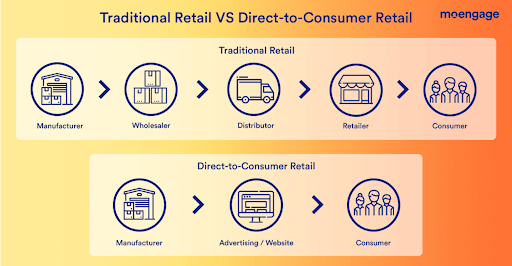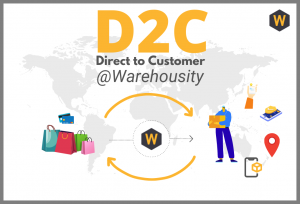Exploring the ROI of Working With a D2C Ecommerce Agency
Wiki Article
Discovering the Potential of D2C Ecommerce: A Comprehensive Guide for Services
The D2C ecommerce model provides a considerable change in just how brands engage with consumers. It allows business to bypass conventional retail channels, fostering deeper links and possibly increased profit margins. This approach is not without its intricacies. Comprehending the subtleties of D2C ecommerce is important for brand names aiming to thrive. What techniques can they take on to navigate this developing landscape efficiently? The answers might redefine their business approaches.Comprehending the D2C Ecommerce Design

Secret Benefits of D2C Ecommerce for Brands
The D2C ecommerce design uses brands considerable advantages, particularly pertaining to enhanced revenue margins. By getting rid of intermediaries, firms can keep a larger share of sales revenue. In addition, this direct relationship with consumers promotes improved brand name commitment, motivating repeat acquisitions and long-term interaction.Enhanced Profit Margins

Enhanced Brand Commitment
Building on the monetary benefits of D2C ecommerce, boosted brand name loyalty arises as one more necessary advantage for business involving directly with consumers. By establishing a direct connection, brands can cultivate much deeper partnerships with their consumers, obtaining understandings into behaviors and preferences. This direct interaction enables even more personalized marketing techniques, which resonate highly with customers. Furthermore, brand names have the chance to manage their messaging and consumer experience, reinforcing brand worths and building trust. When clients really feel a personal link, they are a lot more likely to return, support for the brand name, and take part in neighborhood interaction. Ultimately, improved brand name commitment not just drives repeat acquisitions yet also grows an enthusiastic client base, additional strengthening a brand name's setting in the marketplace.Challenges Faced by D2C Brands
D2C brand names encounter numerous considerable challenges that can affect their success. Stock monitoring concerns can cause equip lacks or excess, complicating procedures and consumer satisfaction. In addition, marketing budget plan restraints typically restrict the capability to efficiently engage and get to target market.Supply Management Issues
Reliable inventory monitoring provides a formidable difficulty for many brands running in the direct-to-consumer (D2C) area. These brand names frequently come to grips with changing demand, which can bring about overstock or stockouts, inevitably impacting client complete satisfaction and profits. Furthermore, the lack of innovative stock monitoring systems can lead to discrepancies between actual stock degrees and reported information, making complex order fulfillment. The varied series of items D2C brand names usually supply also complicates stock management, as variations in sizes, colors, and styles need even more careful oversight. In addition, many D2C businesses may have a hard time with restricted warehousing capacities, bring about inefficient use area and resources. Reliable inventory management remains a crucial difficulty for D2C brand names intending for lasting growth and functional efficiency.Advertising Spending Plan Constraints
Steering advertising budget plan constraints is a substantial obstacle for several direct-to-consumer (D2C) brands. Minimal funds commonly restrict these firms' capacity to buy all-inclusive marketing techniques, resulting in lowered presence in an open market. D2C brand names regularly face the need to make the most of return on investment (ROI) while targeting particular target markets properly. This obstacle is intensified by increasing expenses in digital advertising and marketing and the need to allocate funds throughout several networks, including social media sites, online search engine, and e-mail advertising. Consequently, numerous D2C brand names should innovate economical advertising and marketing services, leveraging organic growth methods and influencer partnerships. Eventually, efficiently navigating these budget constraints is essential for sustaining development and attaining long-lasting earnings in the progressing ecommerce landscape.Methods for Developing a Successful D2C Ecommerce Company
As consumers increasingly seek direct connections with brand names, developing an effective D2C ecommerce company calls for a tactical approach that prioritizes consumer interaction and depend on. One effective strategy is to develop compelling brand name stories that reverberate with target audiences, fostering psychological connections. Using social media platforms can boost visibility and assist in two-way interaction, enabling brands to involve straight with customers.Moreover, customized experiences with tailored marketing initiatives can greatly boost client retention and loyalty. Applying commitment programs and offering exclusive bargains can further incentivize repeat purchases.Streamlining the buying process is crucial, making sure an easy to use user interface that enhances the purchasing experience. Furthermore, clear interaction regarding shipping and returns constructs trust fund and motivates customer confidence.Finally, actively here looking for client feedback and reacting to it shows a dedication to enhancement and customer contentment, crucial aspects in the affordable D2C landscape.Leveraging Modern Technology for Boosted Consumer Experience
In today's affordable D2C ecommerce landscape, modern technology plays a critical duty in shaping consumer experiences. Businesses increasingly use sophisticated devices such as expert system, chatbots, and customized formulas to enhance interactions and enhance the purchasing procedure. By integrating these modern technologies, brand names can offer tailored item suggestions based on specific choices and purchasing habits, fostering a much more engaging experience.Moreover, receptive internet site layouts and mobile applications ensure that customers can access services perfectly across numerous devices. Boosted settlement options, consisting of one-click check outs and digital purses, better simplify transactions, making it less complicated for consumers to make purchases.Data analytics likewise makes it possible for organizations to collect understandings into client actions, allowing for continuous renovation of services and offerings. Overall, leveraging technology not just boosts customer complete satisfaction however also cultivates commitment, inevitably driving long-term success in the D2C ecommerce field.Advertising Tips to Drive D2C Sales
Just how can brands properly catch the interest of consumers in a saturated market? To prosper in the direct-to-consumer (D2C) landscape, brands need to employ targeted advertising and marketing methods. Utilizing social networks platforms, brands can involve customers with interactive content, influencer collaborations, and user-generated articles. Customized email projects can likewise promote a feeling of link, using tailored promotions based on customer behavior and preferences.Moreover, narration plays a vital role in distinguishing a brand name's narrative, making it memorable and relatable. Brands should purchase search engine optimization (SEARCH ENGINE OPTIMIZATION) to boost presence, ensuring their products are conveniently discoverable online. In addition, leveraging information analytics permits organizations to refine their marketing methods and understand consumer trends much better. Eventually, a multi-channel approach that incorporates imagination with data-driven insights can considerably enhance D2C sales, allowing brand names to attract attention in a crowded industry.Future Patterns in D2C Ecommerce
With the quick advancement of innovation and consumer choices, the future of D2C ecommerce is positioned for substantial makeover. Arising trends suggest a shift towards hyper-personalization, where brands utilize data analytics to tailor offerings to private customer needs. This modification enhances client experiences, promoting commitment and engagement.Moreover, sustainability is ending up being a necessary variable, with customers progressively preferring brand names that prioritize environment-friendly techniques - D2C Ecommerce Agency. Firms are expected to adopt clear supply chains and lasting products to fulfill this demand.The assimilation of synthetic intelligence and boosted reality will furthermore reinvent the shopping experience, permitting customers to picture items in their settings before purchase. Furthermore, social business is expected to grow, as systems like Instagram and TikTok facilitate smooth shopping experiences directly within social media.These trends jointly symbolize a dynamic future for D2C ecommerce, highlighting customer-centric techniques and ingenious innovations that redefine customer interactionsOften Asked Inquiries
What Industries Advantage Many From D2C Ecommerce?
The present concern highlights markets that grow through direct-to-consumer (D2C) ecommerce. Remarkably, style, beauty, electronic devices, and food markets leverage D2C models to raise brand commitment, improve client relationships, and maximize earnings margins properly.Exactly How Do Shipping Costs Impact D2C Pricing Techniques?
Shipping expenses substantially affect D2C pricing methods. Businesses should stabilize these expenses with competitive prices, thinking about consumer expectations and profit margins. Effective management of shipping can enhance customer contentment and drive sales in direct-to-consumer designs.
What Repayment Choices Should D2C Organizations Offer?
D2C businesses should offer varied payment choices, consisting of credit/debit cards, digital pocketbooks, and acquire now, pay later on services. This selection boosts consumer convenience, boosts conversion rates, and accommodates various consumer preferences in the on the internet buying landscape.Exactly How Can D2C Brands Deal With Consumer Returns Efficiently?
D2C brands can take care of customer returns effectively by implementing straightforward return policies, offering prepaid delivery tags, and guaranteeing punctual refunds (D2C Ecommerce Agency). Clear interaction and structured processes boost consumer contentment and urge repeat serviceWhat Lawful Factors To Consider Exist for D2C Ecommerce Procedures?
Lawful factors to consider for D2C ecommerce procedures include compliance with customer defense laws, data privacy policies, copyright legal rights, and tax needs. Brands must navigate these complexities to stay clear of lawful risks and assure smooth procedures. By removing middlemans, D2C brand names can use affordable rates and foster an extra intimate connection with their customers.The D2C model is defined by its dependence on electronic systems, allowing brands to utilize social media, on the internet markets, and their very own web sites to involve with customers straight. D2C ecommerce helps with the collection of useful client data, enabling brand names to tailor their offerings and marketing techniques properly, ultimately driving sales and increasing margins. In addition, brand names have the opportunity to control their messaging and consumer experience, enhancing brand name values and constructing trust fund. As consumers significantly seek straight connections with brands, developing an effective D2C ecommerce business requires a tactical technique that focuses on customer interaction and trust fund. D2C brand names can manage client returns effectively by executing user-friendly return policies, using pre-paid shipping labels, and ensuring punctual refunds.Report this wiki page